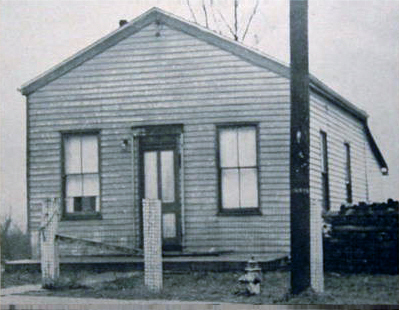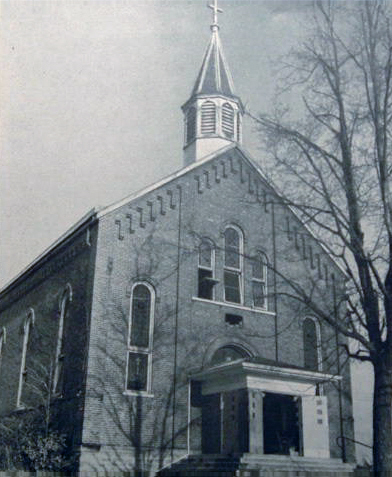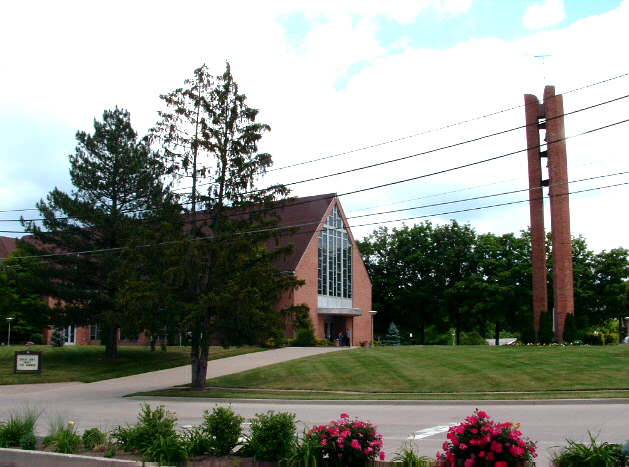
St Joseph Catholic Church History
Cold Spring
Submitted by Norb DeJaco
Information comes from the St Joseph dedication program
booklet dated
Sunday, April 9, 1961
HISTORY OF ST. JOSEPH CHURCH - The first indication of the organizing of a congregation in Cold Spring, Kentucky, is found in 1870. The baptismal records of the parish for that year record seven Baptisms, administered by Reverend Caspar Wiese, Chaplain of St. Joseph Orphanage The first church at Cold Spring was a small frame structure, erected on the site of the church built in 1882. A parish school, a frame structure, was opened within the next few years. Brother Joseph Merschmann, Brother of Mary, who lived at St. Joseph Orphanage, and was later ordained a priest of the Diocese, was the first teacher.

St Joseph's Church-1870
In 1881, Reverend Herman Kramer, the newly appointed pastor of St. Joseph Parish, made plans for a new church to supplant the little frame structure. The clay for the bricks was dug from the slope south of the church, near St. Joseph Orphanage Cemetery, and the bricks were baked in kilns erected near that site. The new church, which served the needs of the parish until December 20, 1960, was dedicated by Bishop Toebbe on Sunday, October 8, 1882. It was forty by ninety-two feet, having a good sized sanctuary and a chapel opening from the Gospel side for the Sisters. The congregation at that time numbered sixty-eight families.

St Joseph's Church-1882
Bishop Toebbe arrived in Cold Spring in a carriage on October 8, accompanied by some of the clergy. He was received by the St. Joseph and St. Aloysius Societies of the Cold Spring Parish, and by St. Martin’s Men Society and St. Aloysius Young Men’s Society of St. Mary Parish, Alexandria, Kentucky, accompanied by the Knights of St. George of Covington, Kentucky, and a full band and guard of honor. The cavalcade made a picturesque appearance. Following the dedication ceremonies by Bishop Toebbe, Father Kramer offered a Solemn High Mass in the new church in the presence of the Bishop. The choir of Corpus Christi Parish, Newport, Kentucky, sang the Mass. After the Mass Bishop Toebbe confirmed a class of twelve. Reported cost of the church was $5,500.00.
In 1882 Reverend Francis Hund succeeded Father Kramer, serving the parish for the next seventeen years. From the material of the church Father Hund erected the first parish house. In 1892 he built a two-story school to rep1ace the original one. During the pastorate of Reverend George Kaufman (1909-1928) the first rectory was replaced by a brick structure which served the parish needs till 1954, when an addition was added by Reverend Lawrence N. Leinheuser to take care of the needs of the pastor, two assistants and the housekeeper. The Golden Jubilee of the parish was observed on September 18, 1921. The celebration was a home-coming event for many former members of the parish. The jubilee sermon was preached by Rev. Matthias Leick, pastor of Corpus Christi Parish, Newport, Kentucky. Towards the end of Father Kaufmann’s pastorate he was engaged in formulating plans for a new brick school building, but months of illness and finally death brought his pastorate at St. Joseph Parish to a close.
Reverend Joseph Broerman who became pastor in March, 1929, took up the task of building a building a new school. A one-story brick building was erected on a large campus about a quarter of a mile south of the church on U. S. Highway 27. In 1931 Reverend Leo S. Streck was appointed pastor of St. Joseph, Cold Spring. On September 23, 1945, under the direction of Father Streck, the parish observed its Diamond Jubilee.
On September 4, 1948, Father Streck was succeeded by Father Lawrence N. Leinheuser. For some time it had been apparent that more school room would be needed for the rapidly increasing parish. Many new homes and some subdivisions were being erected within the limits of the parish. Catholic families in increasing numbers moved into the parish. The number of school children amounted to well over two hundred. Additional school space had to be provided, and the new pastor was faced with the task of providing that space without delay.
Various plans had been considered One was to join two more rooms to the four room brick school building. For a time a Quonsett Hut type building was contemplated. After due consideration of all the needs and circumstances these plans were discarded by the new pastor in favor of an entirely new building. The parish had increased so greatly in numbers that the basement in the brick school not inadequate to accommodate the number of people at social gatherings, festivals, and entertainments. Then, too, it was felt that a gymnasium was needed for an athletic program for our youth. It was therefore decided that a combination gymnasium-auditorium in conjunction with the necessary classrooms would best serve all these needs. Plans were therefore drawn up with these needs in mind. Thus the fourth school building came into being in St. Joseph Parish. Ground was broken for the new school by the pastor, Father Lawrence N. Leinheuser, November 21, 1949, the Feast of the Presitation of Our Lady.
In drawing up plans for this new building
the future of the parish was kept in mind. More land adjacent to the existing
school was bought. On seven different occasions additional land was acquired.
Some land was donated, about six acres. Today the parish property consists of
about 23 acres. Thus the New School was erected close to the third school
building, and enough building space was acquired to serve the future expansion
needs of the parish. The gymnasium-auditorium was built large enough to take
care of all foreseeable requirements. The school part was designed in such a
way that when more classrooms are needed they can be added without sacrificing
architectural beauty. This part of the building is consequently in the shape of
an L, to one wing of which more classrooms can be joined when they
become necessary. in 1953 an addition was built to the New School to provide
more classrooms, living
quarters for the sisters, and a School chapel where Mass was said on school days
for the children. It was felt that walking the children along U.S. Highway 27
from parish church to school was hazardous. In 1951 the school had 235
children, taught by the Sisters of Notre Dame. In 1960 there were 725 children
in school, taught by 11 Sisters of Notre Dame and 5 lay teachers.
The cornerstone of the New School was laid on September 11, 1960, the Feast of
Our Sorrowful Mother. Since ground for the building was broken on the Feast of
the Presentation of Our Lady, and the school bears the name of St. Joseph, we
feel that the school is under the special protection of Mary and Joseph, the
earthly educators of the Child Jesus in the first Christian family and the
first Christian school. And so in full confidence we place the
Christian family and the first Christian school. And so in full
confidence we place the school under the protection of the Holy Family. The New
School was dedicated May 14, 1951, by the Most Reverend William T. Mulloy.
Due to the rapid increase of the parish a larger church became necessary. In
1950 three Masses sufficed to meet the needs of parishioners. In 1954 a second
assistant priest was appointed to the parish. More room had to be provided and
more Masses were added on Sundays. It finally became necessary to have eight
Masses on Sundays, six in church and two in the School Chapel. Even that did
not suffice and the pastor felt the overcrowded conditions in the church
constituted a hazard to the people. So permission was obtained from the late
Most Reverend William T Mulloy to proceed with plans for anew church and
rectory. Since more school classrooms were also needed, it was decided to
have four classrooms in the basement of the new church at ground level.
Edward J Schulte and Associates, Cincinnati, Ohio were selected as architects of
the new plant.
The numerous conferences between the Pastor and Architect, studying requirements, functions, etc., provided the close cooperation necessary to produce a successful solution to the design of the proposed buildings. Ground was broken for the New Church by the pastor on April 11, 1959. The cornerstone was laid November 22, 1959 by the Rt. Reverend Msgr. Herbert Hillenmeyer, P.A., Administrator of the Diocese.
The general architectural conception of the Church is strongly contemporary in character, harmonizing with the existing buildings. The exterior is a warm range of brick, terminating in a brown shingle roof. An aluminum canopy, with the inscription, “Come Let Us Adore,” in combination with symbols of Christ, shelters the main entrance doors to the Narthex. Above the canopy is a colorful display of stained glass, incorporating the symbols of the patron saint of the parish, St. Joseph.
On entering the Narthex, we find a room paneled in warm tones of oak, with recessed pamphlet racks to provide an unobtrusive display of religious reading material. Lights recessed in the ceiling form a very pleasing and unusual design. To the left of the entrance doors is the Baptristy. It too is lined with oak paneling. On the opposite side of the Narthex is the Cry Room, providing a haven for mothers with infants, enabling them to assist at Mass both visually and audibly.
From the Narthex one enters directly into the Nave through clear glass paneled wood doors. Awareness of the marvelous display of stained glass in the aisle windows is immediate. The lovely form of the laminated wood trusses leads the eye directly to the Main Altar, of golden buff marble, with its reredos soaring heavenward to embrace the Tester which extends the full length of the Sanctuary. Mounted on the reredos is a large hand. carved Crucifix from Oberammergau which is surrounded by life size paintings of Saints, representing all walks of life, both clergy and laity. Thus the idea of the Communion of Saints with Christ, the Head of the Church in the center surrounded by His Saints, was carried out. The paintings of the Saints were executed by the well-known artist, Carl Zimmerman of Cincinnati, Ohio.
The Sanctuary is separated from the Nave by a Communion Rail of oak. A lectern, with symbols of the Evangelists, rises from the Sanctuary rail. On the Gospel side is an intimate Chapel dedicated to the Blessed Virgin under the title of Our Lady of the Snows. The marble altar of this Chapel was imported from Italy. The exterior wall of the Transept has a Shrine, Our Sorrowful Mother, flanked by two confessionals, above which is magnificent stained glass window, depicting the Fifteen Mysteries of the Rosary. The large window at the front entrance depicts St. Joseph, the Patron of the church, in symbols. The twelve side windows symbolize the five seasons of the Ecclesiastical Year, Advent, Christmas, Lent, Easter, Pentecost and the Seven Sacraments. Another confessional is located in the side aisle of the Nave.
The ceiling of the church is wood, finished
to harmonize with the wood trusses. Acoustical tile has been installed in the
side aisle ceilings and the vertical portions of the Nave. Ceramic tile in
shades of green and rich brown covers the entire floor, providing a
durable surface which requires the minimum amount of maintenance. The specially
designed lighting fixture, harmonizing beautifully with the interior, contain
concealed lights for soft illumination of the ceiling, down lights for reading,
and recessed speakers which are part of the public address system.
Four classrooms, opening directly to a playground, are provided in the basement
of the church. Opposite the classrooms is a large meeting room which can also
be used as an additional chapel or
classroom. The Rectory contains quarters for the Pastor, his two assistants,
housekeeper, and guest rooms for two visiting priests. A community room on the
second floor serves as a place of recreation for the priests.
Located on the first floor is the housekeeper’s suite, adjacent to a well
equipped kitchen. Entirely separated from the living quarters are the
offices and meeting rooms, permitting several conferences and meetings to
proceed simultaneously.
Mass was offered up for the last time in
the old church on December 20, 1960, and the first Mass, a High Mass for the
people of the parish, was said in the new church on December 21, 1960. The
church was dedicated by the Most Reverend Richard H. Ackerman, S. T. D., Bishop
of Covington, on April 9, 1961.

St Josephs Church-2005
Pastors: Rev Caspar Wiese, 1870; Rev William H Tappert, 1872; Rev Stanislaus
Bellinger, 1872; Rev P Huerer, 1873; Rev F Wehrle, 1873-1876; Rev Frederick
Heising, 1877; Rev L H Jaspers, 1878; Rev Joseph Merschmann, 1878-1880; Rev
Herman J Kramer, 1881-1882; Rev Francis X Hund, 1882-1889; Rev Charles Diemer,
1899-1907; Rev Henry B Gellenbeck, 1907-1909; Rev George Kaufmann, 1909-1928;
Rev Richard O’Neill, 1928-1929; Rev Joseph Broerman, 1929-1931; Rev Leo J Streck,
1931-1948; Rev Lawrence N Leinheuser, September 4, 1948.